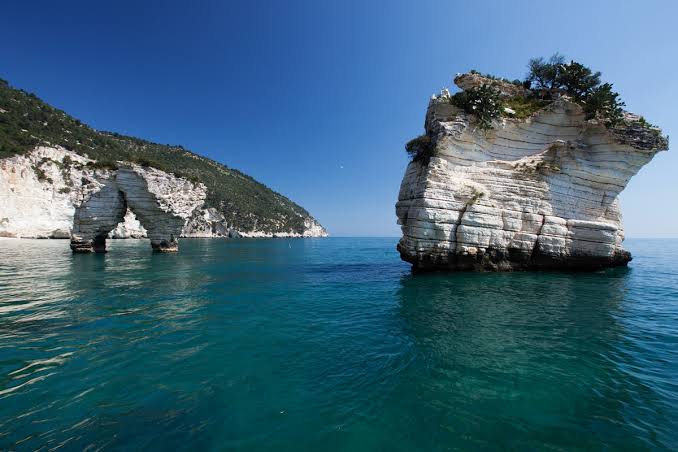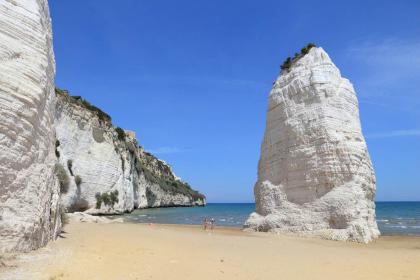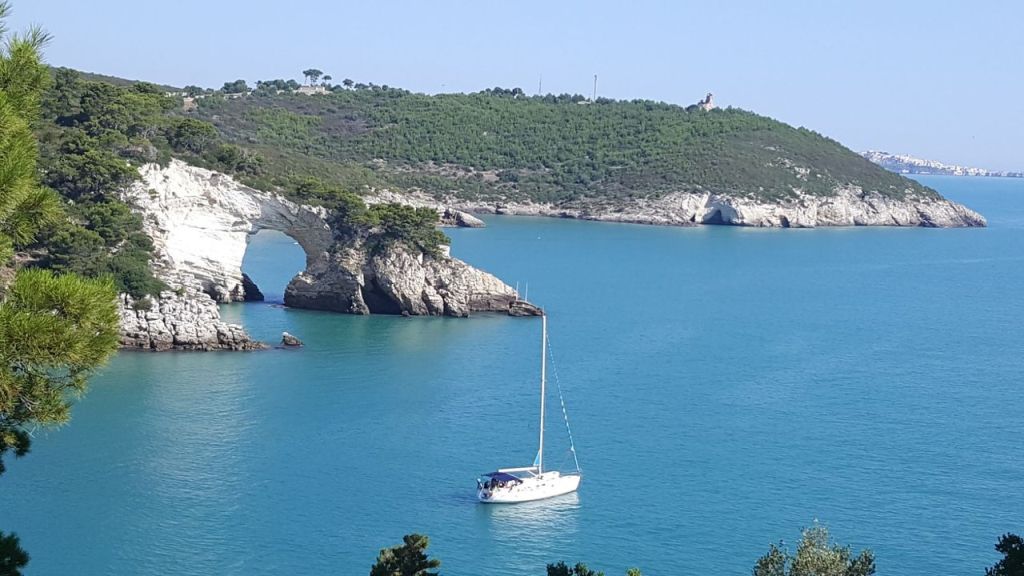




 Vieste is the easternmost city of the entire Gargano Promontory, in an isolated position in relation to the other Gargano centers, a reason why in the past it got the name "La Sperduta". Despite this isolation, thanks to easy-to-access routes, the town has developed considerably over the past few decades, enhancing tourism and becoming a favorite destination for tourists on holiday in the Gargano. With its top quality hotels, its immense sandy beaches, numerous campsites and hotels, Vieste is the "pearl of the Gargano" immersed in the clear blue waters towards which it stretches out so earning several times the recognition of the Blue Flag by the Foundation for Environmental Education. A destination for thousands of tourists from all over the world, it offers to its visitors scenarios of incomparable naturalistic and historical beauty: from the coasts that fall overhanging the sea to the nineteenth century part constituted by its famous historical center. Vieste is one of the oldest cities in Daunia, although its origins are uncertain. According to legend, it was even founded by Noah, who would have landed here and buried his wife Vesta (hence the town's name). Others identify it with the ancient "Apenestre" following the numerous archaeological finds recently discovered.
Vieste is the easternmost city of the entire Gargano Promontory, in an isolated position in relation to the other Gargano centers, a reason why in the past it got the name "La Sperduta". Despite this isolation, thanks to easy-to-access routes, the town has developed considerably over the past few decades, enhancing tourism and becoming a favorite destination for tourists on holiday in the Gargano. With its top quality hotels, its immense sandy beaches, numerous campsites and hotels, Vieste is the "pearl of the Gargano" immersed in the clear blue waters towards which it stretches out so earning several times the recognition of the Blue Flag by the Foundation for Environmental Education. A destination for thousands of tourists from all over the world, it offers to its visitors scenarios of incomparable naturalistic and historical beauty: from the coasts that fall overhanging the sea to the nineteenth century part constituted by its famous historical center. Vieste is one of the oldest cities in Daunia, although its origins are uncertain. According to legend, it was even founded by Noah, who would have landed here and buried his wife Vesta (hence the town's name). Others identify it with the ancient "Apenestre" following the numerous archaeological finds recently discovered.
 The inhabited center is situated on a small rocky peninsula, delimited by two peaks that separate its three bays: Punta San Francesco, facing east, steeper and rocky, where the medieval center with its historic buildings is located; Punta Santa Croce, facing north and lower, where the new inhabited center extends. It is in this last part where the port of Vieste is located, that for centuries has been an important commercial point of reference, for the trade with the countries on the other side of the Adriatic and currently allows the sea links with the Tremiti Islands, Croatia and Manfredonia.
The inhabited center is situated on a small rocky peninsula, delimited by two peaks that separate its three bays: Punta San Francesco, facing east, steeper and rocky, where the medieval center with its historic buildings is located; Punta Santa Croce, facing north and lower, where the new inhabited center extends. It is in this last part where the port of Vieste is located, that for centuries has been an important commercial point of reference, for the trade with the countries on the other side of the Adriatic and currently allows the sea links with the Tremiti Islands, Croatia and Manfredonia.
 Characteristic symbol of Vieste is the famous Pizzomunno monolith, which rises at the height of 25 mt. near the "Castello" beach, south of the Punta San Francesco. A legend tells that a fisherman was transformed into it by the sea gods jealous of his love reciprocated by Cristalda, a beautiful girl, daughter of one of the sea gods, who was in turn chained in the depths of the sea. Through the intercession of other gods being moved by the eternal love sworn by the two boys, every hundred years, in the full moon of August, the woman is freed from the chains to meet her lover, once again a man.
Characteristic symbol of Vieste is the famous Pizzomunno monolith, which rises at the height of 25 mt. near the "Castello" beach, south of the Punta San Francesco. A legend tells that a fisherman was transformed into it by the sea gods jealous of his love reciprocated by Cristalda, a beautiful girl, daughter of one of the sea gods, who was in turn chained in the depths of the sea. Through the intercession of other gods being moved by the eternal love sworn by the two boys, every hundred years, in the full moon of August, the woman is freed from the chains to meet her lover, once again a man.
 Although the coasts of the Gargano dive abruptly into the sea, there is no lack of beaches of considerable vastness and great beauty. In the territory of Vieste, gorges, caves and bays follow one another for about 20 km, with the highest concentration of all Gargano. The sand of the Vieste beaches, with their soft silvery pink color, always sparkling, is of the finest quality, the best of the Adriatic coast, soft more than velvet, impalpable as a powder and the man's foot sinks easily while walking.
Although the coasts of the Gargano dive abruptly into the sea, there is no lack of beaches of considerable vastness and great beauty. In the territory of Vieste, gorges, caves and bays follow one another for about 20 km, with the highest concentration of all Gargano. The sand of the Vieste beaches, with their soft silvery pink color, always sparkling, is of the finest quality, the best of the Adriatic coast, soft more than velvet, impalpable as a powder and the man's foot sinks easily while walking.
Near Vieste there is an archaelogical site called "Necropolis of Salata" datable to the 4th-5th century AD, it is the oldest evidence of the arrival of Christianity on the Gargano